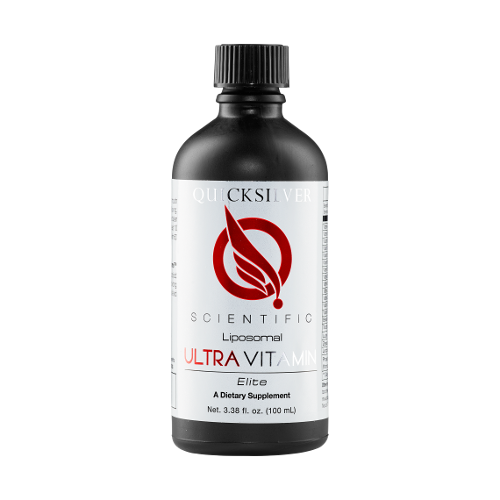Liposomal Delivery Systems Promise Enhanced Bioavailability in New Launches
Quicksilver Scientific’s liposomal delivery systems star in three new launches, including a liquid multivitamin, an energy supplement, and a hemp CBD serum.
Photo from Quicksilver Scientific

Liposomal delivery technology from a company called Quicksilver Scientific (Lafayette, CO) is front and center in several new 2017 product launches, including an “ultra-strength multivitamin,” an energy supplement, and a hemp cannabidiol (CBD) serum. And while the ingredients in these products may be very different, the liposomal delivery system they all use serves a similar function in each-enhancing bioavailability and supporting cellular membrane function, says Quicksilver.
As Quicksilver explains it, liposomes are microscopic single- to multilayer spheres made of phospholipids (the basic building blocks of cell membranes). These lipid structures, or liposomes, are typically more absorbable by the body, and they are able to cross the blood-brain barrier. According to Quicksilver, however, not all liposomes are created equally, and some manufacturers may use low-grade phospholipids that render the liposome less absorbable. By contrast, the company says, Quicksilver ensures that its liposomes are made from high-quality ingredients. The company is now licensing its technology to other dietary supplement firms, as well as creating its own products.
To start with, Quicksilver Scientific recently announced the debut of its own Quicksilver Scientific Ultra Vitamin, a liquid formula for oral intake, which it calls the “first liposomal multivitamin.” The new product combines Methyl B-Complex and PuRx Vitamin C ingredients with lutein, zeaxanthin, lycopene tomato complex, and vitamins A ,D3, E, and K2 as menaquinone-7. Bringing it all together is the “pharmaceutical-grade liposomal delivery system,” which includes phospholipids to support cellular membrane health and function.
Quicksilver has also rolled out a new energy supplement, dubbed The One, which it describes as a “balanced nootropic and mitochondria-generating combination.” It includes the proprietary, branded Sun Horse adaptogenic herbal blend, providing pyrroloquinoline quinone (PQQ), CoQ10, trans-resveratrol, and DeltaGold tocotrienols. This ingredient combination is designed to support mitochondria production, healthy antioxidant levels, and the generation of energy in the form of adenosine triphosphate (ATP). Quicksilver says the unilamellar bilayer liposomal vesicle not only provides good bioavailability but also provides phosphatidylcholine to support membrane health.
Finally, a company called THR Technologies (Lafayette, CO) has released a new CBD serum called Nanocalm 300 microemulsified hemp extract, which licenses Quicksilver Scientific’s liposomal delivery system to enhance ingredient absorption into the bloodstream. Thanks to the liposomal delivery technology, the active ingredients are delivered in nano-sized droplets (less than 100 nm particles), which enables “intra-oral absorption and avoids breakdown in the digestive tract,” according to Christopher Shade, PhD, CEO and founder of both Quicksilver Scientific and THR Technologies.
Shade talked to Nutritional Outlook about what typically makes engineering stable liposomal systems so challenging. For one, he says, a particular combination of ingredients in a supplement can make it more difficult to achieve a stable liposomal delivery system overall. For instance, he says, with Quicksilver’s Ultra Vitamin, even though the supplement contains ingredients the company already had experience working with in a liposomal matrix (Methyl B-Complex, nanoemulsified vitamins D3 and K2, and liposomal vitamin C), the addition of the multiple carotenoid ingredients (beta-carotene, lycopene, lutein, and zeaxanthin), plus the additional vitamin A and vitamin E, made the Ultra Vitamin delivery system more challenging.
“This really is a long list of both fat- and water-soluble compounds, and although each can be made stable with relative ease in a unique liposome or nanoemulsified particle, the combination of these becomes a very complicated thing,” explains Shade. “When we mix this long list of nutrients together, they do not necessarily remain stable in their individual liposomal or nanoemulsified package. This is because, much like a droplet of water which nears another droplet, like substances have a tendency to fuse and become a larger droplet. If the particles were to re-assemble and fuse together into larger particles, this basically would abolish any of the benefits we set out to achieve with our very small liposomal and nanoemulsified delivery system.”
In addition, he adds, when the lipid vesicles are further exposed to air, the antioxidants in the ingredient mix will begin to oxidize. In order to maintain stability, the company had to “tweak” its technology, he says. “In order to keep the particles stable, a significant amount of ‘tweaking’ of the solution of water, glycerin, and alcohol, which makes the mixture fluid and optimizes oral delivery, was require to stabilize the particles.”
“Blending and optimizing combinations of nutrients and other compounds into liposomes and nanoemulsions really is not much unlike the work of a master chef, and is both an art form and a science,” he continues. He advises companies that “liposomes and nanoemulsions, while they may be an ideal supplement delivery vehicle, are definitely not the easiest things to make, particularly to make well."
"If they were," he adds, "we would see a lot more companies offering them as a part of their product line. Even though at Quicksilver Scientific we specialize in liposomal and nanoemulsified delivery systems, there are even occasions when producing these products is difficult for us.”